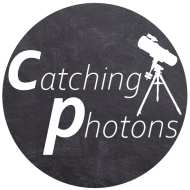Here I will list the software I use. Most of the listed software is free to use and work fine for me.
Acquisition
Sharpcap
THE Software for planetary capturing. SharpCap supports most of the cameras on the marked and has mighty tools like „polar alignment“ and „focus finder“ build in.
APT
Software dedicated to control your Camera for a Deep Sky session. Connects to Canon DSLRs and other cameras. Can connect to PHD2 for dithering – can plate solve and control the mount if needed.
Pre-Processing
Deep Sky Stacker
Software to stack the single exposures taken for a Deep Sky Session on top of each other. Thereby the single images will be summed/ averaged to one single image containing the data of the entire session.
Free – Easy – Necessary
Autostakkert!3
Software to stack planetary video files taken with SharpCap/other capturing software. It will analyze the data, sort the single frames by quality and stack them to one single frame. Autostakkert can also sharpen the final result, do RGB-align and other important stuff.
Crucial for planetary imaging.
RegiStax6
Registax6 is a mighty piece of software. It can perform nearly all post capturing steps for planetary imaging: aligning, quality estimation, sorting, stacking and post processing. As Autostakkert!3 (for me!) is an easier way of stacking the data, I personally use Registax to apply sharpening and rgb-alignment to the images. The sharpening algorithms (wavelet functions) are superb and super mighty!
PIPP
PIPP is a planetary pre-processor software. It can convert nearly any video format into raw .avi or fit files, can crop video files, stabilize them around the centered planet etc. The video convert mode very handy.
Post-Processing
GIMP
GIMP is a opensource image manipulation software. Think of it as a free Photoshop. I use GIMP mainly for editing my DSO images. Despite the common opinion that GIMP is much less intuitive to use: the basic functions for image stretching, color alignment, curves, sharpening, noise reduction and stuff can easily be done in GIMP.
Thereby it is my first suggestion for anyone going into DSO imaging.
paint.net
You search for an easy way of quickly editing your images? Rescale, resize, label or reset quality? paint.net is a free piece of software, supports multi layer and the most common editing features. Though the curve stretching and histogram editing functions are much more sophisticated in GIMP/Photoshop, paint.net supports all basic editing functions in an easy and intuitive way.
Astronomy Software
ASCOM
ASCOM is a platform to connect the software-side to the hardware-side. Instead of having drivers for every capturing or guiding software for every telescope mount or camera, ASCOM supports some kind of „middle-ground“. Every developer has to build a ASCOM-driver to connect to the platform. ASCOM will then „tunnel“ the information from software to hardware and vice versa.
Quote: ASCOM is a many-to-many and language-independent architecture, supported by most astronomy devices which connect to Windows and now Linux and MacOS computers.
EQMOD
EQASCOM is a driver, that will support you with a virtual „handheld“ and the depending drivers that are the direct link to your mount. Rather than to enter new coordinates or to control slewing properties via your handheld you simply connect your mount directly to your PC and control it via EQASCOM. Thereby you simply choose EQASCOM within the ASCOM settings and everything will be super easy!
Quote: EQASCOM is a telescope driver that provides the astronomical ‚brains‘ of the mount control system. It provides functions such as:
- Control of the mount using any ASCOM compliant planetarium software or client application
- Gotos/Slew at 0.144 resolution (depending on planetarium database accuracy and mount type)
- Slew Speeds variable between x1 to x800 of the sidereal rate.
- Spiral Search
- SYNC via ASCOM / Planetarium Software
- Enhanced positioning accuracy via 1-Star Alignment/ N-Star Multi-Point Telescope Mount Error Modelling
- Gamepad / Joystick support for telescope control.
- …
Stellarium
Stellarium is a free open source planetarium for your computer. It shows a realistic sky in 3D, just like what you see with the naked eye, binoculars or a telescope.
Stellarium allows you to enter the specs of your telescope and your camera and enables you to display your field of view (FOV). Does a certain object fit into your frame? Have a look!
You can control the mount via Stellarium. That is very handy! I highly recommend downloading Stellarium to get used to the night sky and to get a grip on FOVs.
PHD2
PHD2 is telescope guiding software that simplifies the process of tracking a guide star, letting you concentrate on other aspects of deep-sky imaging or spectroscopy.
You simply connect PHD2 to your mount (via ASCOM) and to your guidecamera (via ASCOM or build in drivers) and PHD2 will perform an initial calibration and then uses the position of a chosen guide-star to keep your DSO perfectly stabel. PHD2 will counteract missed polar alignment and mount imperfections to a certain level. You can easily increase the max. exposure time from 1-2 minutes up to 10 minutes! Guiding is necessary for every advanced user!
AstroTortilla
AstroTortilla is a free plate-solving software. This means that AstroTortilla connects to your mount (via ASCOM) and a camera (via ASCOM or native driver) and takes an image of the night sky. Then AstroTortilla will search for stars and their position and compares those coordinates with an internal database. AstroTortilla will then be able to tell exactly where your scope is pointing in the night sky and update the internal position memory of the scope. Thereby AstroTortilla can counteract any slewing imperfections of your mount. It is highly necessary for anyone who wants to find small targets (planets, galaxies) with long focal lengths or wants to do mosaic images.
